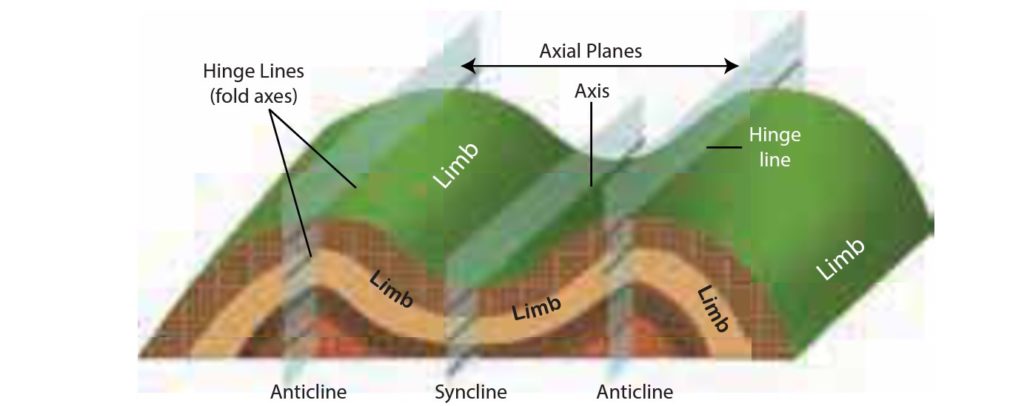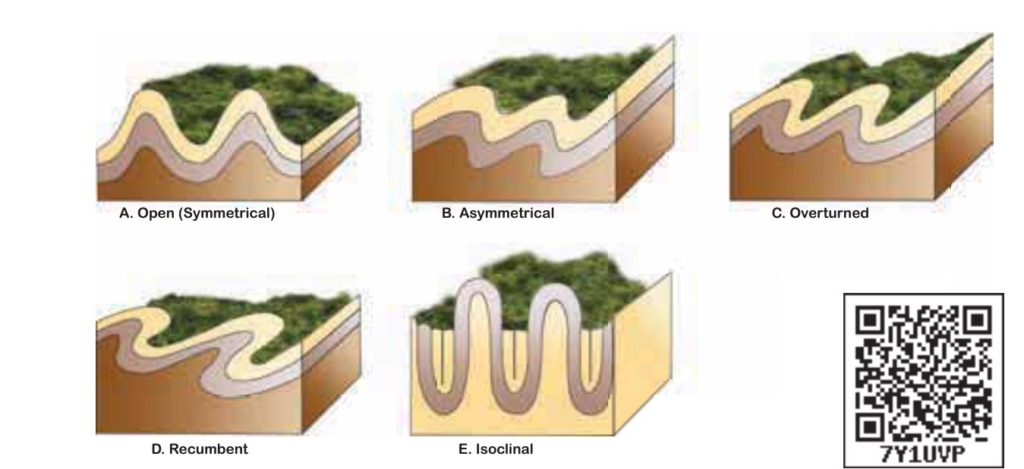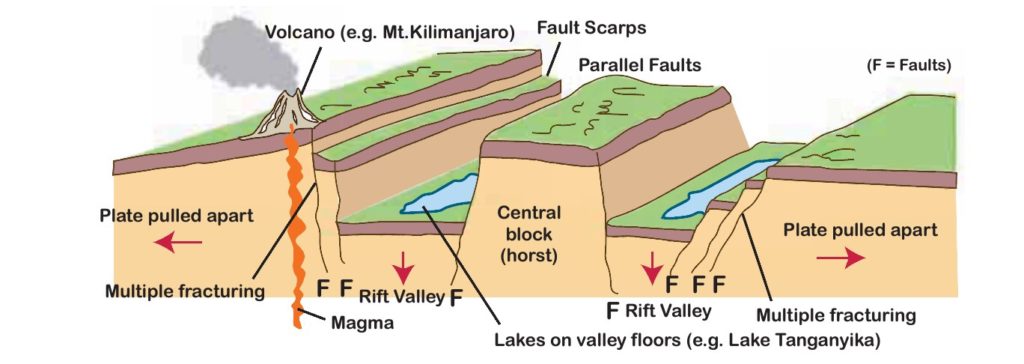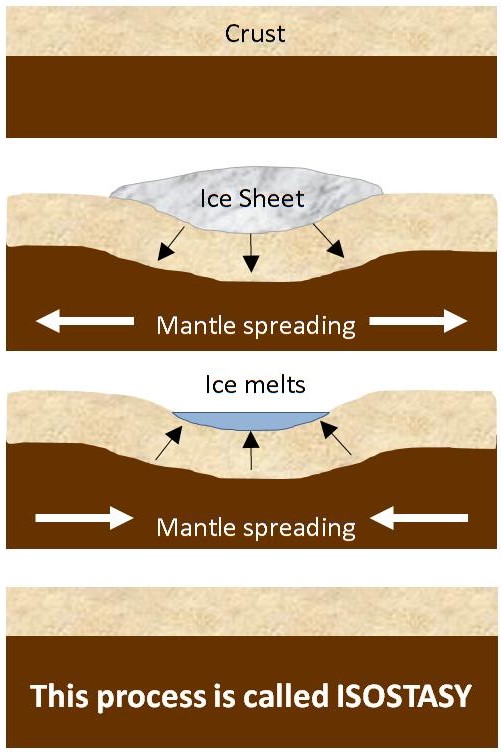Table of Contents
Mountains
This article deals with ‘Mountains.’ This is part of our series on ‘Geography’ which is important pillar of GS-1 syllabus . For more articles , you can click here
Folding and Faulting
Process of mountain formation involves concepts of Folding and Faulting. Hence, we will first learn about these concepts.
1 . Folding
- Folding is the bending of rock strata due to compression.
- Folding on a large scale results in mountain building referred to as orogeny
- Up thrown part of a fold is called anticline. Down thrown part of a fold is syncline. The side of the fold is a limb

Types of folding
| Symmetrical fold | When compressional force is equal from both sides, the angle of the limb is same on both sides. |
| Asymmetrical fold | When compressional force is more from one end, one limb is steeper than the other. |
| Isoclinal folds | similar to symmetrical folds, but these folds both have the same angle and are parallel to each other |
| Over turned fold | When one limb of the fold is pushed over the other limb of the fold, it is called as over turned fold. |
| Recumbent fold | When one side of the fold is pushed so much that it lies positioned over the other |

2. Faulting
A fault is a break in earth’s crust where blocks of rock crust slide past each other.
Types of Faults
2.1 Normal Fault
- Vertical displacement of the crust is called a normal fault.
- Normal fault is caused by tensional forces where plates diverge.
- One block lies above and other block lies below the fault

Landforms made by Normal fault are:
- Rift Valley or Graben : When a narrow block of land drops or subsides between two parallel normal faults, rift valley (Graben) is formed. Eg : River Rhine Rift valley between Black Forest and Vosges, Narmada Rift Valley between Satpura and Vindhya and Great African Rift Valley
- Horst : When a block of land between two faults is pushed up, block mountain or horst is formed. In this case, the central block is not only up thrown but the side blocks are also relatively downthrown . Eg : Mountains Vindhya and Satpura.


2.2. Reverse Fault
- Reverse fault is a horizontal displacement of the crust.
- It is caused by compressional forces

2.3 Shear Fault
It is created by shearing along transform boundaries. Rocks on either side of fault slip past each other sideways with little up or down motion

Classification of Mountain Ranges of the world
Mountains can be categorised in different ways
1 . Classification of Mountains on the basis of height

2. Classification on basis of location

3. On basis of period of formation

We have to note the fact that Mountains are born & have finite life span like
| Young mountains | High, steep & growing upward (like Himalayas and other Alpine mountains). |
| Middle aged mountains | Cut by erosion |
| Old mountains | Deeply eroded & often buried (like Aravalli, Appalachians etc) |
Types of Mountains on basis of formation
Based on difference in process of their formation, there are following types of mountains :-
- Fold Mountains
- Bock Mountains
- Volcanic Mountains
- Domed Mountains
1 . Fold Mountains

Folded mountains are formed due to folding of crustal rocks by compressive forces generated by the convergence of tectonic plates. Eg :
- Convergence of Indo-Australian and Eurasian plate leads to the formation of Himalayas.
- Convergence of American and Pacific plate leads to formation of Rockies
- Convergence of South American and Nazca plate leads to formation Andes
Process of their formation is known as Orogeny. It is not a continuously happening process in the geological past but it happens intermittently. In whole of the geological past, total 9 Orogenies have happened of which last four are important for us
- Pre-Cambrian Orogeny ( Laurentian , Algoma etc)
- Caledonian (Aravallis, Appalachian etc )
- Hercynian Orogeny (mountains include Mountains of Iberian Peninsula, Spanish Messeta etc )
- Alpine Orogeny (they are the youngest and are still rising. Mountains include Andes, Rockies, Himalayas, Alps, Atlas etc)
Characteristics of Fold Mountains
- Extensive mountain chain spread over large area .
- They are of great height .
- Formed along unstable parts of earth and plates are active there . Hence, earthquakes are quite common in this region.
- Sedimentary deposits of marine origin are also found in this .
Fold Mountains also have age –
- Himalayas are one of the youngest ranges & that is why they are so high .
- Aravalli is one of oldest mountain range . After million of years Aravalli is still standing , this vouches for its great heights during youthful stage ( which might be even higher than Himalayas )
Side Topic : Phases in formation of Mountain Ranges
1st Stage : Oceanic-Continental Collision
- Convergence of Ocean & Continental Plate.
- This will lead to formation of mountains on the Continent-Ocean margin.
- Examples include Andes Mountain at convergence of Nazca and South American plate.

2nd Stage : Development of Geo-Syncline
- This is developed between Mountains & Trench .
- In this , sediments from river as well as from ocean keep on accumulating
- And geo-syncline is formed
3rd Stage : Continental -Continental Collision
- Ultimately whole of ocean plate will be subsumed .
- Then continental continental plates will collide and compressive forces cause folding of Continental Crust along with squeezing and folding of sediments and material at the Geo-Syncline (reason why Marine Sediments are found in Fold mountains)

2. Block Mountains

- Block mountains are formed due to faulting in the ground surface. In this case, the central block is not only up thrown but the side blocks are also relatively downthrown
- Block Mountains represent the Horst with Rift valley or Graben on either sides.
- Examples include
- Sierra Nevada mountains of California (USA)
- Salt range of Pakistan,
- Rhine rift valley in Europe
- Vindhya and Satpura in India
3. Volcanic Mountains
- Volcanic Mountains are formed due to Volcanic Activities
- Examples include Mount Kilimanjaro in Africa, Mount Fujiyama etc
- They are formed with the consolidation of Andesitic magma coming out of earth’s crust

4. Upwarped (domed) Mountains
- Formed by upwarding of surface due to pressure on crust from below
- Example : Adirondack mountains of New York.

Side Topic : Isostasy
It is seen that heavily snow covered glacial regions in the Polar belts (eg Norway, Greenland) tend to rise up over long period with the melting of the snow (rebound). Why?
Isostasy is the phenomenon of rebound of the earth’s crust in regions where elevation is reduced due to degradation and relative erosive processes. Here , the rebound compensates reduction in height
Since, Tectonic Plate is floating on Asthenosphere , when mountain is eroded or snow melts there is lowering of mass and hence rebounding of the tectonic plate upwards happen

Importance of Mountains
- Mountains cover 27% of earth’s continents and 20% of population resides here making it an important part of human civilization
- Mountains are great source of resources like Hydroelectricity, Wood, Medicinal plants, wild animals/insects, fruits etc.
- Most of the perennial rivers of the world originate in mountains like Ganga, Brahmaputra, Rhine, Hwang Ho , etc. Human civilizations were made possible by the rivers originating in mountains since most of the old civilizations like Indus valley civilization, Mesopotamian Civilisation (Euphrates) , Egyptian Civilization (Nile) etc flourished on the banks of these rivers
- Mountains are source of attraction for tourism related activities. Large number of people visit mountainous regions as tourists and also helps in generation of employment in those regions.
- They have religious and cultural significance as well. For example, Himalayas are abode to many Hindu gods like Shiva.
- Mountains have their lasting effect over climate of any region. In India, the Himalayas contribute very importantly for rainfall not only through Monsoon winds but through cyclones also.
